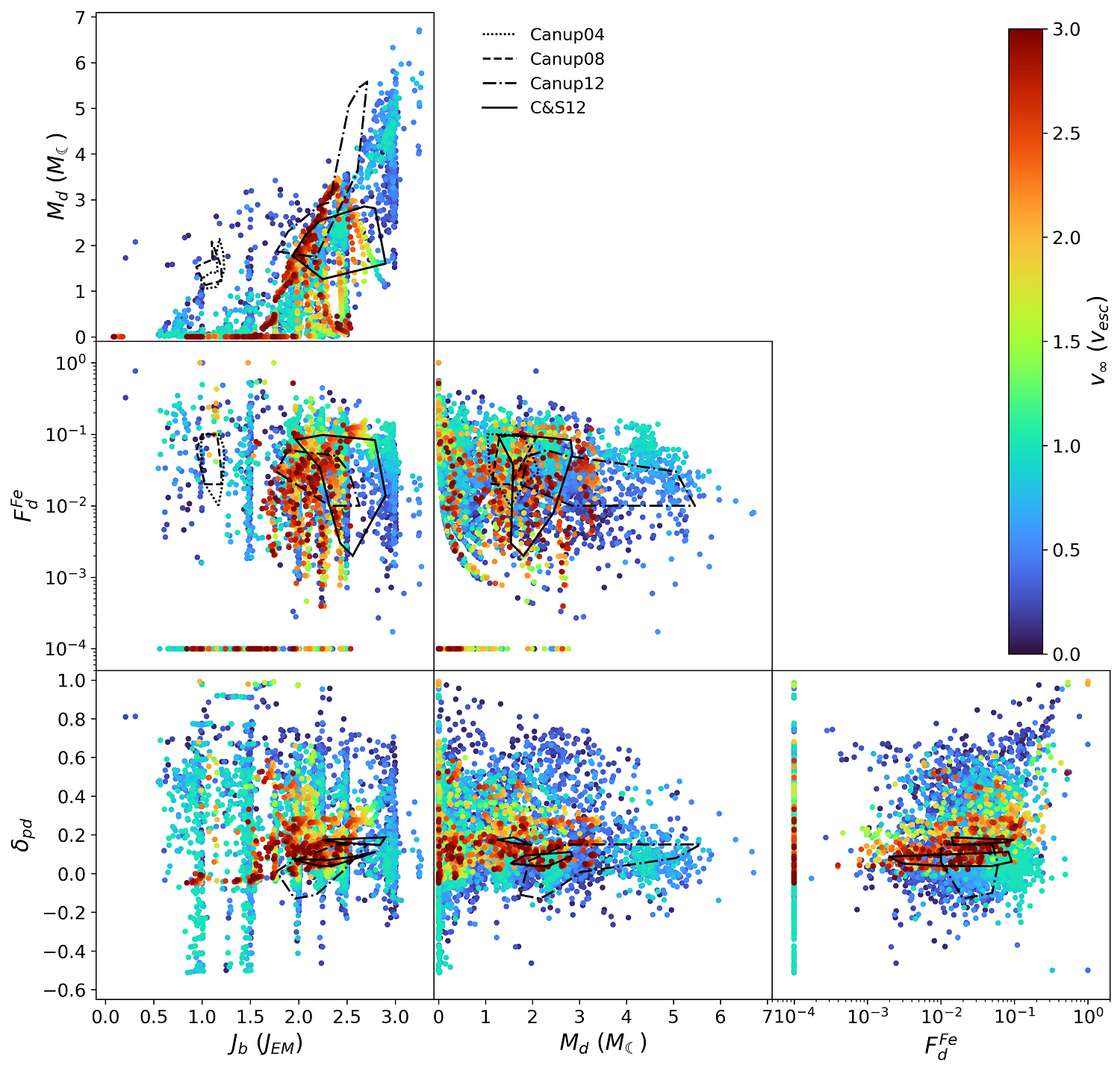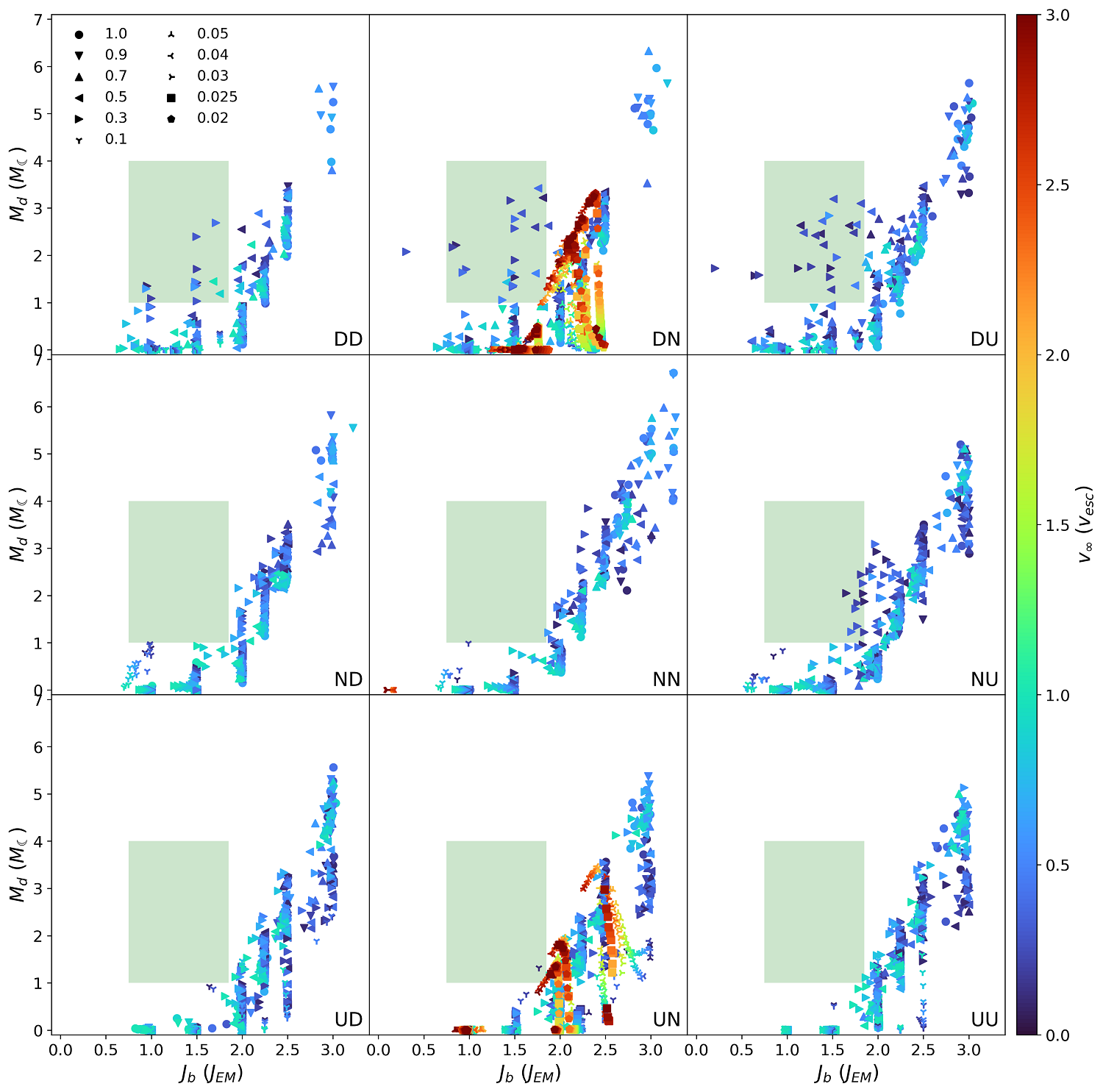A Systematic Survey of Moon-Forming Giant Impacts
- 1University of Zurich, Department of Astrophysics, Switzerland
- 2University of Bern, Physics Institute, Space Research and Planetary Sciences, Switzerland
Introduction: The prevailing theory for the formation of Earth’s Moon is the Giant Impact hypothesis, in which a collision between the young Earth and a massive body ejects material into a circumplanetary disk from which the Moon then forms. In the leading version of this hypothesis, called the “canonical” Moon-forming impact, a Mars-sized impactor (Theia) collided with the Earth in an oblique impact at roughly the mutual escape velocity of the bodies. Prior simulations suggest that about one lunar mass of material is ejected into orbit, from which the Moon later accretes. A successful Moon-forming impact must be consistent with the following observations: 1) It must explain the angular momentum of the Earth-Moon system, 2) eject enough mass into orbit to allow the formation of the Moon, 3) the disk must be depleted in iron compared to the Earth and 4) the isotopic composition of the disk and Earth’s mantle must be similar. To date, no scenario has been found that satisfies all constraints without requiring either special initial conditions (isotopic similarity between target and impactor) or post-impact processes (removal of angular momentum, post-impact mixing). Studies investigating the formation of the Moon usually focus on meeting certain observational constraints and therefore a limited region of the parameter space. A systematic investigation of the parameter space of potential Moon-forming impacts has not yet been performed.
Methods: We present a systematic survey of the parameter space for Moon-forming giant impacts. This study consists of 7649 collision simulations which cover a wide range of the initial angular momentum, the impact velocity, and the impactor-to-target mass ratio. We also include pre-impact rotation for both the target (proto-Earth) and the impactor, where the rotational angular momentum can be either aligned or anti-aligned with the orbital angular momentum. The simulations are carried out using the 3D smoothed-particle hydrodynamics (SPH) and gravity code Gasoline, with numerical improvements for giant impact simulations. The colliding bodies are modelled as a two-layer sphere, using the ANEOS equation of state for both the iron core and the rocky mantle. Bodies with pre-impact rotation are created by evolving the particle representation in a co-rotating frame with an angular velocity that is slowly increasing until it reaches the desired value and then transferring it to the stationary frame. The collision outcomes are then analyzed using a novel disk finder algorithm to distinguish between the planet and the circumplanetary disk. From this we then calculate the bound angular momentum, the disk mass, the disk iron mass fraction, and the mixing between impactor and target material in the collision.
Results: The set of simulations presented here, which systematically samples the pre-impact parameter space, produces a very diverse set of outcomes (see Figure 1), including disk masses between 0-6.71 ML (lunar masses). Notably, no simulation was identified that could satisfy all four of the known constraints.
Without pre-impact rotation, no collision produced a sufficiently massive disk (Md > 2 ML) below a bound angular momentum of 2 JEM (see center frame of Figure 2). Collisions with pre-impact rotation can fill some parts of the post-impact parameter space that are not populated by collisions without pre-impact rotation. For example, massive disks can be created by collisions with very low impactor-to-target mass fractions (gamma < 0.1), and we find excellent mixing for all impactor-to-target mass fractions, but massive disks and good mixing are limited to impactor-to-target mass fractions >= 0.5 and the scenario with fast counter-rotating target and very low impactor-to-target mass fraction. By adding pre-impact rotation, we also find results that satisfy both the constraints on disk mass and angular momentum. However, in those cases the disk is predominantly composed of impactor material and therefore they do not satisfy the mixing constraint. Nonetheless, we find plenty of cases that satisfy any combination of three out of the four constraints.
Around 3% of the simulation results show a massive bound fragment (between 0.5 and 1.5 ML) orbiting in the disk. These fragments either form directly by tidal deformation of impactor material and material excavated from the target or by fragmentation of spiral arms. Such direct formation of (proto) satellites can occur for a wide range of impact conditions. Their composition can be anything between target to impactor dominated and we also find cases with excellent mixing. The fate of such fragments is unclear as they could either be eroded by tidal forces or serve as a seed for the formation of the Moon. In the latter case, constraints on the disk mass and the mixing parameter may change, as this may increase the accretion efficiency. As the accreted material does not necessarily mix with the deeper layers of the Moon, this also allows for differences in the composition between the surface and the deep interior of the Moon.
Conclusions: In our systematic survey of the Moon-forming giant impact parameter space, we find no single case that can satisfy all observational constraints without requiring very specific pre-impact conditions or post-impact processes. We also find that the canonical Moon-forming impact cannot produce sufficiently massive disks without significant pre-impact rotation. A modified canonical impact with a counter-rotating target can produce massive enough disks but these disks are then strongly impactor dominated. In general, collisions with pre-impact rotation can produce massive disks at much lower angular momentum, allowing to reconcile the angular momentum and disk mass constraints. The presence of gravitationally bound fragments found in a small fraction of cases could significantly alter the disk mass and mixing constraints; as a result, the community may be forced to reconsider the currently accepted set of constraints.

Figure 1: Post-impact variables of all 6247 simulations that result in a merger.

Figure 2: Top panel of Figure 1 split into the 9 different spin configurations.
How to cite: Meier, T., Reinhardt, C., Timpe, M., Stadel, J., and Moore, B.: A Systematic Survey of Moon-Forming Giant Impacts, Europlanet Science Congress 2024, Berlin, Germany, 8–13 Sep 2024, EPSC2024-74, https://doi.org/10.5194/epsc2024-74, 2024.